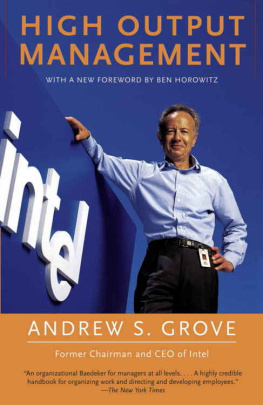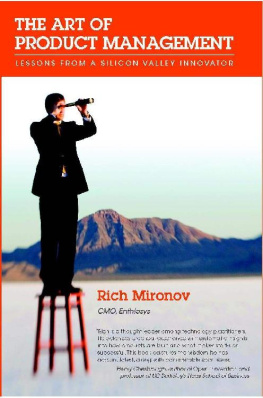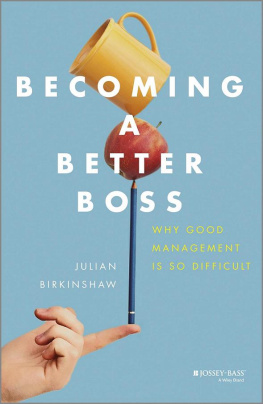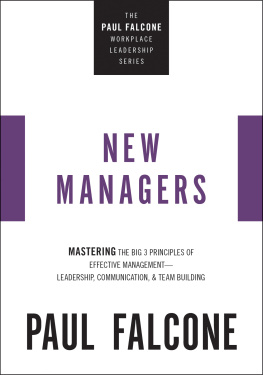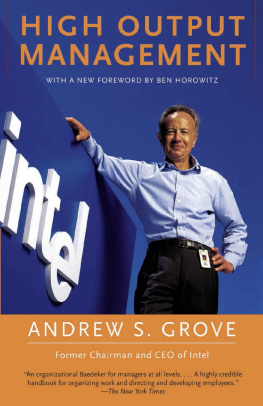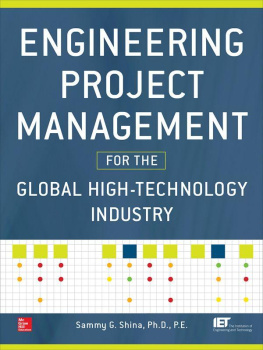Grove Andrew S. - High output management
Here you can read online Grove Andrew S. - High output management full text of the book (entire story) in english for free. Download pdf and epub, get meaning, cover and reviews about this ebook. City: New York, year: 2015, publisher: Vintage, genre: Romance novel. Description of the work, (preface) as well as reviews are available. Best literature library LitArk.com created for fans of good reading and offers a wide selection of genres:
Romance novel
Science fiction
Adventure
Detective
Science
History
Home and family
Prose
Art
Politics
Computer
Non-fiction
Religion
Business
Children
Humor
Choose a favorite category and find really read worthwhile books. Enjoy immersion in the world of imagination, feel the emotions of the characters or learn something new for yourself, make an fascinating discovery.
- Book:High output management
- Author:
- Publisher:Vintage
- Genre:
- Year:2015
- City:New York
- Rating:4 / 5
- Favourites:Add to favourites
- Your mark:
High output management: summary, description and annotation
We offer to read an annotation, description, summary or preface (depends on what the author of the book "High output management" wrote himself). If you haven't found the necessary information about the book — write in the comments, we will try to find it.
The essential skill of creating and maintaining new businessesthe art of the entrepreneurcan be summed up in a single word: managing. In High Output Management, Andrew S. Grove, former chairman and CEO (and employee number three) of Intel, shares his perspective on how to build and run a company. Born of Groves experiences at one of Americas leading technology companies, this legendary management book is a Silicon Valley staple, equally appropriate for sales managers, accountants, consultants, and teachers, as well as CEOs and startup founders. Grove covers techniques for creating highly productive teams, demonstrating methods of motivation that lead to peak performancethroughout, High Output Management is a practical handbook for navigating real-life business scenarios and a powerful management manifesto with the ability to revolutionize the way we work.
**
ReviewAn organizational Baedeker for managers at all levels. . . . A highly credible handbook for organizing work and directing and developing employees.The New York Times
[Andys] book played a big role in shaping my management style.Mark Zuckerberg, cofounder and CEO of Facebook
A good book, generous enough with advice and observations to be required reading.The Wall Street Journal
A great book. . . . Its elementary prescriptions form the basis of a highly effective management style.San Francisco Chronicle
An important book which says some very important things . . . beautifully and with style. Peter Drucker
High Output Managementis a bible that every entrepreneur and every manager in the country should look at, read and understand.Bill Campbell,former Intuit CEO
Andy exemplifies the best of Silicon Valley. Andy built the model for what a high quality Silicon Valley company could be.Marc Andreessen, creator of the original Mosaic and Netscape web browsers
From the Inside FlapThis is a user-friendly guide to the art and science of management from Andrew S. Grove, the president of Americas leading manufacturer of computer chips. Groves recommendations are equally appropriate for sales managers, accountants, consultants, and teachers--anyone whose job entails getting a group of people to produce something of value. Adapting the innovations that have made Intel one of Americas most successful corporations, High Output Management teaches you:
what techniques and indicators you can use to make even corporate recruiting as precise and measurable as manufacturing
how to turn your subordinates and coworkers into members of highly productive team
how to motivate that team to attain peak performance every time
Combining conceptual elegance with a practical understanding of the real-life scenarios that managers encounter every day, High Output Management is one of those rare books that have the power to revolutionize the way we work
Grove Andrew S.: author's other books
Who wrote High output management? Find out the surname, the name of the author of the book and a list of all author's works by series.

